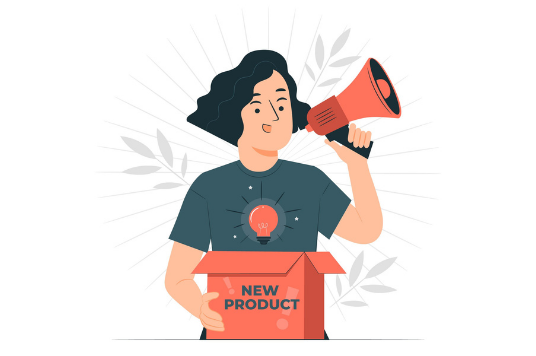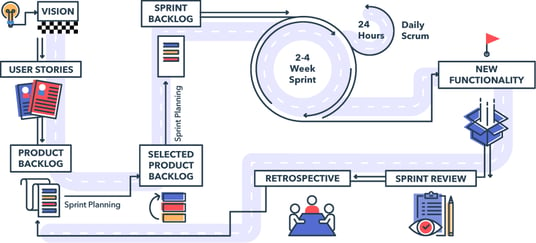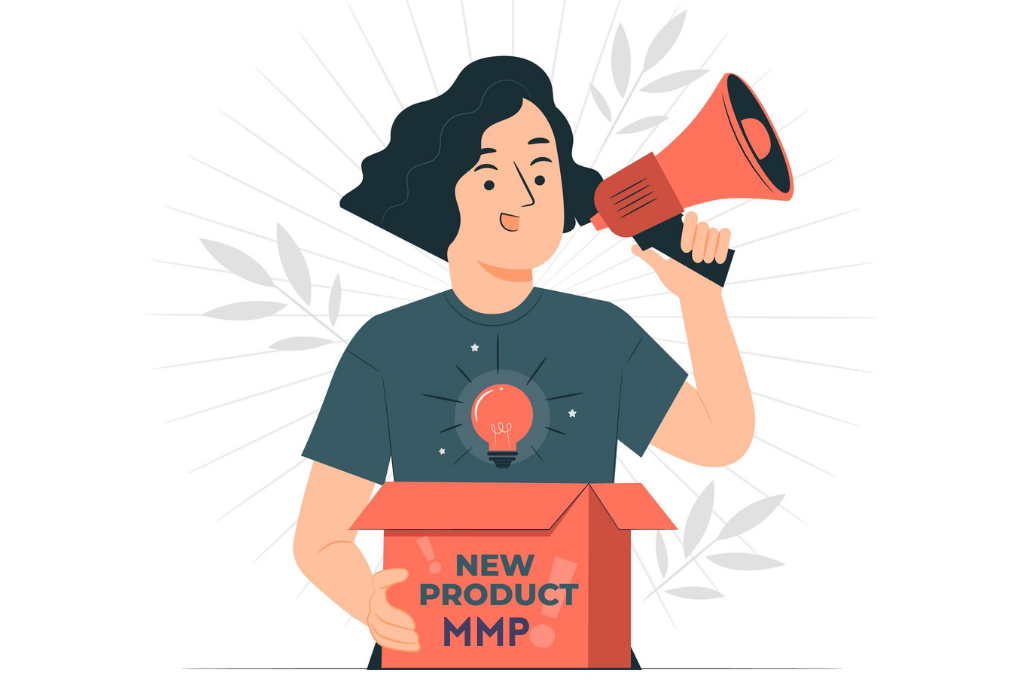Digital products have become the crux of every business. Today, every enterprise, SMB, and startup has a digital product to meet and exceed the expectations of digitally-conscious customers. However, in order to offer the best value, many end up building over-engineered products, which are cluttered and hard to comprehend. Additionally, they come with an extra maintenance cost.
Combined together, such products end up being a loss more than a gain for an organization.
That's why following the agile software development approach for building an MVP before launch has become a common practice among businesses of all sizes and scales. In fact, unicorns like Facebook, Spotify, Uber, Airbnb, and others have succeeded with an MVP.
However, considering the escalated expectations of the digital users, offering the simplest MVP might not be a smart move. They need to make the MVP more marketable before launching in the market.
And that’s where an MMP or minimum marketable product comes in. This is the development phase that comes between building a minimum viable product and the product launch.
.png?width=1080&name=inbound-process-img%20(1).png)
An MMP is a product that has the simplest features yet is made more presentable to be launched in the market. It offers all the benefits that an MVP offers like:
-
Reducing or mitigating the risks
-
Testing the UX functionality
-
Analyzing the market demand
-
Verifying monetization strategy
-
Getting clarity and validation for the product idea
-
Ensuing cost-efficiency
-
Faster market release
Also Read: How Much Does MVP Development Cost? Learn To Calculate
These are the benefits that are promised to any startup or product company when they begin with an MVP development. But just reaping and enjoying these benefits isn’t all for someone launching a new product. They need to be sure that it is ready for a bigger audience once it is out there in the market.
This is when the MMP comes to play.
In addition to offering all the benefits offered by a minimum viable product, an MMP also offers surety of success.
Wondering how?
Let’s find out.
What Is A Minimum Marketable Product?
We’ve all read and heard about minimum viable products but very little has been written about minimum marketable products. And that is why we are throwing light on this.
Not much has been written or said about an MMP. But this is one of the most crucial stages in any successful product launch.
A minimum marketable product is the minimum version of the product that is ready for the market. Following the concept of minimalism, it offers the most important set of features that are required to make it a great market fit.
But, you’d say that that’s exactly what an MVP is - the simplest version of a product. But there’s a difference between the two. Let’s find out below.

Source: Freepik
Minimum Viable Product Vs. Minimum Marketable Product
Before we delve into the details of MMP, it is important for any entrepreneur or product owner to know the difference between a minimum marketable product and a minimum viable product. This will help you not just differentiate between the two but also understand how they work and benefit you in the long run.
Defining Minimum Viable Product
Minimum viable product, in layman's terms, is the simplest version of a product that one uses to test the offering on beta testers and early adopters. This version of the product is sans any fluff and shows the core offering at best.
Minimum: Simplest
Viable: Capable of being successful
Product: Offering to the user
The main goal of an MVP is to test it on people and get the required feedback to be implemented in the next version release. It helps the business validate its idea and move on to analyzing the feedback from the earliest users to make it more presentable for the users.
Defining Minimum Marketable Product
A minimum marketable product is a product that is ready to be marketed to the audience. A minimum marketable product is also called the minimum marketable feature or MMF.
TechTarget defines MMF as the smallest set of functionality in a product that must be provided for a customer to recognize any value. The concept supports the belief that software released to the customer should provide some added benefit, no matter how frequent the releases are.
Minimum: Simplest
Marketable: Capable of offering value & being purchased
Product: Offering to the user
The main goal of an MMP is to make the product as presentable and usable for the audience as possible. It helps the business market the product by improving the user experience to a point where it can be accepted and loved by the target audience.

Difference Between MVP & MMP
Now that we know what MVP and MMP are, let’s delve into some of the differences between the two. MMP is everything that an MVP is and more. It stands for a product that is ready for launch but still is the minimum version of the final product. It is the first version launch that isn’t just targeted at the early adopters but the target customers at large. Unlike MVP, MMP also focuses on the user experience of the product and how it fulfilled the customer expectations. Here's a tabular representation of the difference between MVP and MMP.
| Factor | MVP | MMP |
| Stage | Initial development | Pre-launch |
| Focus | Validating product idea | Addressing user needs and experience expectations |
| Audience | Beta testers, early adopters | Customers |
| Goal | Successful product idea | Successful launch |
MMP: The Stage After MVP
A minimum viable product can be anything from a hypothesis of the product idea to the written/visual wireframe to a simple digital product with a basic interface. The aim is to allow early users to check the concept and offer validation of the same.
However, there is a difference between testing the MVP on known people and launching it in the market.
Once you have received validation for the startup app idea through a minimum viable product, the next step in the development process is to build a minimum marketable product. As we know that an MVP is all about getting feedback from beta testers and early adopters like friends, family, and other close ones, an MMP is what happens next.
This is the stage where you make your product fit for the market.
How do you build a Minimum viable product or move from MVP to MMP?
The answer lies in the type of MVP you have built to get product validation from your target users.
No Product MVP: This will be a long process as you are starting with just a visual representation of your idea. Here, you will need to build a product development team to build the product MVP. Once the MVP is done, you can move ahead to get designers and developers to build user interfaces and implement feedback for MMP development.
Product Mockup: This is a shorter approach as you already have the idea validated via a simple product prototype. It has no advanced technologies - just the core offering. This can be turned into an MMP by improving the interface, incorporating feedback from MVP, and enhancing the UX.
Single Feature MVP: This is the best approach for MVP development and even allows shorter time to launch with MMP. One just needs to enhance the experience & focus on customer needs if the idea has been validated through that feature.
.png?width=536&name=MVP%20development%20guide%20(11).png)
MLP: This is the minimum lovable product and already has the features and functionalities to make the users love it. This one does not need too many changes or additions to be made into an MMP.
EVP: An Exceptional Viable Products is the almost completed version of the product MVP and can directly be launched in the market. There is a huge difference between MVP and EVP, and the latter is the most polished version that needs not to be turned into MMP.
Paper Prototype: This is just a visual representation of how you want the product MVP to look like. However, you can certainly not take it to the market. It would need MVP development and later, complete addition of the marketable feature and improved UX or launch.
While it depends on how your MVP was when you received validation from the early adopters, there are some specific requirements that one takes to move from MVP to MMP. Here are those:
Hire UI/UX Designers
You need to hire more UI/UX designers and improve the look and feel of the product. It is about to get launched in the market and should be easy to use and intuitive. This is why you need to hire designers to improve the front-end of the product. You can even hire remote developers from India to cut costs for your launch.
Eliminate Added Features
This is where you make your MVP into a minimum marketable feature with just a single feature to not confuse the audience. Added features may make your product look either complex or the same as others. It might even confuse some users. Hence, to make it into an MMP, it is imperative that you remove any added features that might clutter the product during the launch.
Implement Feedback
MVPs leave behind a ton of data from the feedback received and the data collected from user behavior. This feedback should be incorporated into the MMP. Following the agile software development approach makes it easier to implement feedback and iterate accordingly.
Enhance Usability
The user experience is what can make an MVP into a successful MMP. It is essential that the viable product be added with a better user interface that is intuitive and easy to navigate. Moreover, there should be an added ease in using the product, making it usable for all of the target audience.
What Makes An MMP Successful?
A successful minimum marketable product is known to have features that are easier to market and sell to the audience. It helps minimize risks when going big with the product and launching it out there.
Great User Experience: The most important thing that will make any MMP stand out is the user experience. An MVP doesn’t focus on the UX of the product while an MMP ensures the UX is on point.
Demonstrated Future Benefits: In order to be marketable, it is important for it to demonstrate some type of future benefits. An MMP ensures that it has the demonstrated benefits for future use and the same should be mentioned in the scope of software MVP.
Value Proposition: Another important factor to consider when building an MMP is the value that it offers. As it is minimum, the only feature present in the product should address the users’ main needs and provide value for the same.
Feedback Loop: As the MMP is just the first launched version with no added features, it needs to have a feedback loop from where the product development team can pick up data for the development of the future versions.
Focus On Customer Needs: In order to make the product more presentable to the audience, it is imperative that you focus on the customer’s needs. If the product offers what the customers need, it will automatically become a success, no matter how simple it is.
Interface: The interface is another important feature that requires attention when in the MMP phase. It should be intuitive and yet offer a unique experience that is so seamless that anyone could easily navigate through it.
Agile & Lean: Ensuring that your MMP is lean means following the approach with utmost sincerity. Adopting the lean and agile approach can help build successful MMP and also leave scope to implement feedback as per the demand & behavior.

Also Read: Agile Software Development In 2021: Benefits, Considerations & Mistakes
Get Started With MMP Development
Despite getting tested and receiving good reviews and feedback from the early adopters, many successful minimum viable products don’t survive in the market, let alone become successful. That is because they do not have the marketable features present in them to be successfully sold and marketed.
You need an MMP to make your product prototype ready for the market. It is decluttered and usually has a single feature that sets the foundation of the product or reflects the core business offering of the startup.
If you are looking to build a minimum viable product and then a minimum marketable product, we can be the software development partner you need.
With around two decades of experience, we have excelled at MVP development. We are agile practitioners and can seamlessly implement the feedback from MVP into your MMP to ensure a quick launch.


























.png)




